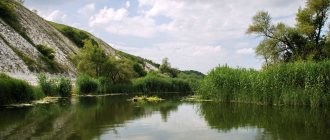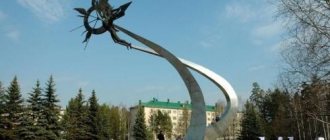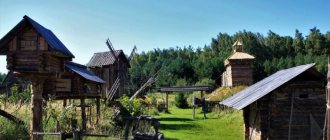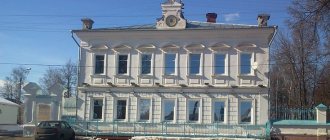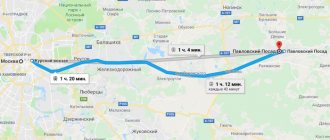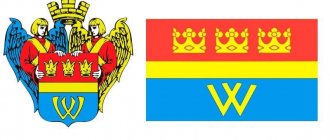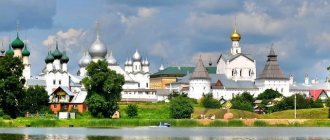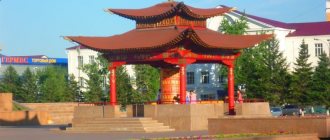Shuya is a city in the Ivanovo region, the former center of the appanage Shuya principality. Famous for one of the tallest bell towers in all of Europe. Shuya is included in the route of the Golden Ring of Russia.
The city belonged to the Shuisky princes, the most famous of whom, Vasily Shuisky, became famous for his reign during the Time of Troubles. During the time of Ivan the Terrible, the city was included in the oprichnina lands. Shuya is located at the intersection of rivers, which contributed to the development of trade relations and the textile industry. This place was visited by Peter the Great, Elizaveta Petrovna and Alexander II.
Shuya is secretly included in the route of the Golden Ring. Here you can read what other cities belong to it and what you can see very close to Shuya.
And more historical and natural attractions around Shuya can be found in the review material on the Ivanovo region.
Shuya city and Shuya river
The city of Shuya is named after the Shuya River, which flows into the Teza. The Ivanovo River Shuya has several namesakes. These are rivers in the basin of Lake Onega, the White Sea, tributaries of the Orsha and Unzha. Therefore, the city of Shuya also has namesakes, for example in Valdai: “...between the large trunks of pine trees, a village can be seen below. A handful of houses. Smoke from pipes. A cart full of hay is crawling across the plain towards the village. Two dogs are running around the outermost hut, and magpies are diving in the air over houses and gardens. You find the name of the village on the map. Shuya... You walk along the ridge, and sleepy Shuya looms for a long time between the pines on the right" (See Peskov V.M. Valdai frost - in the book: Forest Eyes. M., 1979, p. 101.)
What is the origin of the name of the river Shuya? Ours, Ivanovo’s, and the rest?..
There is a fairly common version about the Slavic roots of this hydronym: the name Shuya is explained by the Slavic shuytsa - “left”. Ivanovskaya Shuya really lies on the left bank of the Teza River. And shuytsa could be opposed to the right hand... But the whole point is that the area of the name with the base shuya on the map of Russia practically nowhere closes with the area of the name with the base desn-. What could this mean? Most likely, the stems belong to languages of different families. So, the name Shuya is not Slavic? So which one?
Temples[ | ]
Resurrection Cathedral Cathedral Church of the Transfiguration.
1847 (bell tower - 1869). Blown up on May 1, 1930. The pile of bricks left from the explosion lay on the square for about 30 years. By 1917, there were 20 churches in the city.
On the territory of the settlement there is the Intercession Cathedral (1754). The following churches have also been preserved: Holy Cross (1693, rebuilt in 1823, paintings by T. Medvedev in the 1820s), St. George the Great Martyr (1703, rebuilt in 1817 and 1838). On Green Square stands the temple ensemble of the St. Nicholas Cathedral (1756; northern aisle - 1833), the Resurrection Cathedral (1792-1798, expanded in 1912-1913) and the bell tower (1810-1833, architects Maricelli, E. Ya. Petrov). On the northwestern outskirts of the city there is the Church of the Transfiguration (St. Nicholas the Wonderworker) (1833)[5].
The complex of the Resurrection Cathedral of the early 19th century is famous for its 106-meter bell tower - the first in Europe among belfries standing separately from churches. In 1891, the seventh largest bell in Russia (weighing 1,270 pounds) was raised to the third tier of the bell tower. It was cast in Moscow at the expense of the largest manufacturer M.A. Pavlov. Since 1991, the Resurrection Cathedral has been the courtyard of the St. Nicholas-Shartomsky Monastery - the Shuya Orthodox monastery, known since 1425.
Toponymy of the city of Shuya
They tried to find out the meaning of the name Shuya back in the 18th century. The historian I.N. Boltin (1735-1792) was the first to do this: he emphasized the antiquity of the city and argued that the word Shuya is of Sarmatian (!) origin and means “capital”. Of course, such an assumption was naive.
Only one thing is obvious: the name is not Slavic, but is based on a Finno-Ugric root, which is quite justified from a historical point of view. It can be assumed that such a root could be suo - “swamp” (exists, for example, in modern Finnish). For a long time in the city of Shuya there was a large swamp - right next to the fortifications, and the street nearby was called Bolotnaya. The initial sound of this word could sound like sh or something between sh and s (remember the Karelian-Finnish “lisp” s ). Therefore, the word could be perceived and transmitted by Russians with the initial sh . Well, I (a) , apparently, is an indicator of the feminine gender (after all, the name refers to the word “river”), which arose already on Russian soil. The word suja, which in some Finno-Ugric languages has the meaning “thawed” as well as “open,” could also become the productive basis of the hydronym. In the Mari language this stem means “flood”. From the point of view of nomination principles, such a hypothesis is quite viable.
In terms of further development of this version, it is possible to analyze the fact that the Samoyed and Proto-Ugric languages are characterized by a word-formation model that necessarily includes a geographical term that determines the nature of the object. From this point of view, the name Shuya can be formed not just from “swamp” (shuo), but from “swamp river” (shuo-oya). At the same time, scientists also know the Slavic hydronyms Shuya; other Russian rivers and rivers with the name Shuya can be translated not as Swamp Rivers, but as Left Rivers.
Economics[ | ]
The city has historically been the center of the textile industry, but (as of 2016) in fact, only the Shuya Calico factory operates in the city.
The city has industrial sectors and enterprises:
- production of fire extinguishing systems (NPO "Fire Automation Service")[5]
- Shuisky - electronic equipment[5]
- particle boards, furniture[5] "Egger woodproduct" - production of chipboards.
In 2011, the Grand Hotel Shuya hotel complex of European level (four stars) was opened.
Shuya as Borisoglebskaya Sloboda
The city on the Shuya River did not immediately accept its name. In historical documents it is called either Shuya or Borisoglebskaya Sloboda. Parallelism can also be traced in the following fact: in the charter of Ivan the Terrible, the Lazarev nobles are directly told that their estate is located in the Borisoglebsky, or Shuisky, camp. Why Borisoglebskaya Sloboda? The fact is that Shuya Posad had this name (Vladimir Provincial Gazette, 1846, No. 11; Description of the city of Shuya and its environs. M., 1851, p. 3.). It was formed according to the church in honor of Boris and Gleb (i.e. Borisoglebskaya). The mention in the sources of Shuya as the Borisoglebskaya settlement, it seems, is also not accidental: the importance of the trade and craft settlement was greater compared to the small fort - the city of Shuya itself.
Both in chronicles and in official documents the toponym Shuya appears almost simultaneously - in the first half of the 16th century. In the chronicles we find it under 1539: then Shuya suffered from the raid of the Kazan king Safa-Girey. The oldest document mentioning Shuya is a letter from Ivan the Terrible: “...you granted Ignatius Borisovich Golokhvastov the town of Shuya with truth and with a stain and with a tavern for feeding” (Quoted from: Description of the city of Shuya..., f. 5-6.). We also find mention of Shuya as a city in the famous spiritual letter of Ivan the Terrible, dated June - August 1572: “Yes, I bless my son Fyodor, I give him the city of Suzdal... and the city of Shuya with volosts, and with roads, and with villages, and with all duties" (See Spiritual and contractual documents..., p. 442.).
Content
- 1 Geography
- 2 Etymology
- 3 History 3.1 Shuya Principality
- 3.2 XVI-XVII centuries
- 3.3 XVIII-XIX centuries
- 3.4 Economy before the revolution
- 3.5 Soviet period
- 3.6 Shuya case
- 6.1 Museums
Vasily Shuisky and Shuya
Vasily Ivanovich Shuisky
The toponym Shuya itself also served as the basis for another proper name of a different category. Which one? Let’s open the pages of A. S. Pushkin’s drama “Boris Godunov”; One of the main characters is the boyar Vasily Shuisky. After a long struggle and intrigue, he manages to ascend to the Russian throne for some time. The Shuisky family is really connected with the city of Shuya. At the beginning of the 15th century. with the annexation of Suzdal to Moscow, the former Suzdal princes received the city of Shuya and the surrounding lands as their inheritance, and from Prince Vasily Kirdyana and his son Yuri the Shuisky family descended. Such a surname did not arise by chance; as Professor A. M. Selishchev writes, early family-verbal signs were caused by the feudal-proprietor's tendency to determine the belonging of a particular feudal lord to his clan; among these surnames there were many that territorially determined the region that belonged to the feudal lord - Yeletsky, Zvenigorodsky, Mosalsky, etc. (See A.M. Selishchev. The origin of Russian surnames, personal names and nicknames. - In the book: A.M. Selishchev, Selected works, M., 1968, p. 97.)
Population[ | ]
| Population | ||||||||||
| 1856[26] | 1897[26] | 1926[26] | 1931[26] | 1939[27] | 1959[28] | 1970[29] | 1973[26] | 1976[26] | 1979[30] | 1982[31] |
| 9300 | ↗19 600 | ↗35 500 | ↗44 900 | ↗57 910 | ↗64 562 | ↗68 781 | ↗70 000 | ↗71 000 | ↗71 970 | ↗72 000 |
| 1986[26] | 1987[32] | 1989[30] | 1996[26] | 1998[26] | 2000[26] | 2001[26] | 2002[33] | 2003[26] | 2005[26] | 2008[26] |
| →72 000 | →72 000 | ↘69 313 | ↘69 000 | ↘68 100 | ↘66 800 | ↘66 000 | ↘62 449 | ↘62 400 | ↘60 800 | ↘58 900 |
| 2009[34] | 2010[30] | 2011[26] | 2012[35] | 2013[36] | 2014[37] | 2015[38] | 2016[39] | 2017[40] | 2018[41] | 2019[42] |
| ↘58 541 | ↘58 486 | ↗58 500 | ↘58 357 | ↗58 616 | ↘58 570 | ↗58 795 | ↘58 690 | ↗58 723 | ↘58 114 | ↘57 569 |
| 2020[43] | 2021[1] | |||||||||
| ↘57 039 | ↘56 041 | |||||||||
As of January 1, 2022, in terms of population, the city was in 299th place out of 1,116[44]cities of the Russian Federation[45].
Shuya - city and fort
The city of Shuya grew and was built according to the usual plan, such as: fortress + settlement. It’s just that the wooden fortifications in the city center have been given the name “ostrog”, which has not previously been encountered in our historical and toponymic journey through the “Golden Ring” of Russia. In the documents of the 17th century, where Shuya is discussed, we read: “City and prison.”
Source: Source: M. V. Gorbanevsky, V. Yu. Dukelsky - Through the cities and villages of the “Golden Ring”
"Shartom Ostrich"
Not far from the city there is an ostrich farm, where hospitable owners arrange excursions for everyone.
This place will be especially interesting for children. Here they can pet huge birds, learn about their homeland and even feed cabbage to ostriches
At the farm you can buy environmentally friendly products - eggs, fresh and baked meat, feathers and even handmade ostrich soap.
In these same places it is worth looking at another attraction - Nikolo-Shartomsky Monastery .
"Shartom Ostrich"
Transport[ | ]
City transport is represented by more than 20 bus routes, operating from 4 hours 40 minutes to 22 hours 40 minutes.
Shuya is connected by intercity buses to Moscow, Vladimir, Nizhny Novgorod, Kovrov, Ivanovo, Kineshma and other settlements of the Ivanovo region.
There are railway connections with Moscow (four high-speed Lastochka trains per day), St. Petersburg, Nizhny Novgorod (daily), Samara and Ufa (every other day).
| This section is not completed. You will help the project by correcting and expanding it. |
Notes[ | ]
- ↑ 123
The permanent population of the Russian Federation by municipalities as of January 1, 2022 (Russian). Retrieved April 27, 2022. Archived May 2, 2022. - ↑ 12
THE USSR. Administrative-territorial division of the union republics on January 1, 1980 / Comp. V. A. Dudarev, N. A. Evseeva. - M.: Izvestia, 1980. - 702 p. — P. 122. - Photo of a city sign from the USSR era
- On the administrative-territorial structure of the Ivanovo region (as amended as of 02/04/2015), Law of the Ivanovo region dated December 14, 2010 No. 145-OZ (undefined)
. docs.cntd.ru. Access date: November 30, 2022. - ↑ 12345678910111213141516171819202122232425
BRE, 2022. - Pospelov, 2008, p. 503.
- Kalinin
V. The most ancient cities and villages of Ivanovo land-2 // Ivanovo newspaper. — 04/20/2018. - ↑ 123
Shuisky and Kovrov districts..., 1898, p. 4-5. - Lists of populated places of the Russian Empire (unspecified)
.
Cartologist
(November 15, 2009). Access date: November 30, 2022. - ↑ 12
Shuisky and Kovrov districts..., 1898, p. 6. - Stolbov V.P.V.P.
Stolbov about the Old Believers of Ivanovo
(unspecified)
.
krotov.info
. Access date: November 30, 2022. - Posylin, Alexey Ivanovich // Russian Biographical Dictionary: in 25 volumes. - SPb.-M., 1896-1918.
- Tikhonravov K.
Posylins // Zap. Yuryevsky village village. households - 1860. - Issue. I, adj. — P. 29-30. - 7th Chernigov (Vladimir) named after “Yugo-Stal” Infantry Red Banner Division: History of combat and peaceful life for 10 years. - Chernigov: Publishing house. Political department. State type, 1928. Archived April 26, 2014 on the Wayback Machine
- Ivanovo remembers: golden stars (undefined)
. www.ivanovo1945.ru. Access date: January 27, 2022. - The building in which during the Great Patriotic War of 1941-1945. The 85th Howitzer Regiment of the RGK and the 354th Reserve Rifle Regiment were formed. (undefined)
. nasledie-archive.ru. Date accessed: May 6, 2022. - ↑ 1 2
Countries / Russia / Shuya.
(undefined)
(inaccessible link -
history
). - Krivova N. A.
Power and the Church in 1922-1925.
(undefined)
. Archived from the original on April 7, 2009. - Letter to members of the Politburo dated March 19, 1922 (Lenin) (unspecified)
.
Wikisource
. Access date: November 30, 2022. - Letter from L. D. Trotsky to the Politburo of the Central Committee of the RCP (b) with proposals for repressions against the clergy, adopted by the Politburo with the amendment of V. M. Molotov on March 22, 1922 (unspecified)
. Archived from the original on June 24, 2008. - A monument to the victims of the war on religion was erected (unspecified)
.
Local Demand
(22 August 2007). Access date: March 16, 2022. - The wagon scales have been transformed (undefined)
. Information publication “Local demand” (09/29/2015). - Soap Museum (undefined)
. Access date: March 16, 2022. - By the way.News
.
A new cinema with 2 cinema halls has opened in Shuya, By the way.News
(December 30, 2020).
The first monument to Konstantin Balmont in Russia was unveiled in Shuya . www.okrugshuya.ru. Access date: October 15, 2022.- ↑ 1 2 3 4 5 6 7 8 9 10 11 12 13 14 15
People's Encyclopedia “My City”.
Shuya (undefined)
. Retrieved November 19, 2013. Archived November 19, 2013. - All-Union Population Census of 1939. The size of the urban population of the USSR by urban settlements and intra-city areas (unspecified)
. Retrieved November 30, 2013. Archived November 30, 2013. - All-Union Population Census of 1959. The size of the urban population of the RSFSR, its territorial units, urban settlements and urban areas by gender (Russian). Demoscope Weekly. Access date: September 25, 2013. Archived April 28, 2013.
- All-Union Population Census of 1970 The size of the urban population of the RSFSR, its territorial units, urban settlements and urban areas by gender. (Russian). Demoscope Weekly. Access date: September 25, 2013. Archived April 28, 2013.
- ↑ 1 2 3
Results of the All-Russian Population Census of 2010, volume 1. Number and distribution of the population of the Ivanovo region
(unspecified)
. Access date: March 30, 2022. - National Economy of the USSR 1922-1982 (Anniversary Statistical Yearbook)
- National economy of the USSR for 70 years: anniversary statistical yearbook: [arch. June 28, 2016] / USSR State Committee on Statistics. - Moscow: Finance and Statistics, 1987. - 766 p.
- All-Russian population census 2002. Volume. 1, table 4. Population of Russia, federal districts, constituent entities of the Russian Federation, districts, urban settlements, rural settlements - regional centers and rural settlements with a population of 3 thousand or more (unspecified)
. Archived from the original on February 3, 2012. - The size of the permanent population of the Russian Federation by cities, urban-type settlements and regions as of January 1, 2009 (unspecified)
. Retrieved January 2, 2014. Archived January 2, 2014. - Population of the Russian Federation by municipalities. Table 35. Estimated resident population as of January 1, 2012 (unspecified)
. Retrieved May 31, 2014. Archived May 31, 2014. - Population of the Russian Federation by municipalities as of January 1, 2013. - M.: Federal State Statistics Service Rosstat, 2013. - 528 p. (Table 33. Population of urban districts, municipal districts, urban and rural settlements, urban settlements, rural settlements) (undefined)
. Retrieved November 16, 2013. Archived November 16, 2013. - Table 33. Population of the Russian Federation by municipalities as of January 1, 2014 (unspecified)
. Access date: August 2, 2014. Archived August 2, 2014. - Population of the Russian Federation by municipalities as of January 1, 2015 (unspecified)
. Access date: August 6, 2015. Archived August 6, 2015. - Population of the Russian Federation by municipalities as of January 1, 2016 (Russian) (October 5, 2018). Retrieved May 15, 2022. Archived May 8, 2022.
- Population of the Russian Federation by municipalities as of January 1, 2022 (Russian) (July 31, 2017). Retrieved July 31, 2022. Archived July 31, 2022.
- Population of the Russian Federation by municipalities as of January 1, 2022 (Russian). Retrieved July 25, 2018. Archived July 26, 2022.
- Population of the Russian Federation by municipalities as of January 1, 2022 (Russian). Retrieved July 31, 2019. Archived May 2, 2022.
- Population of the Russian Federation by municipalities as of January 1, 2022 (Russian). Date accessed: October 17, 2022. Archived October 17, 2022.
- taking into account the cities of Crimea
- https://rosstat.gov.ru/storage/mediabank/bul_Chislen_nasel_MO-01-01-2021.rar Population of the Russian Federation by municipalities as of January 1, 2022 (1.85 Mb, 07/30/2021)
- Shuya time (Russian). Date accessed: September 11, 2022.
Education[ | ]
Higher and secondary specialized:
- Shuya branch of Ivanovo State University (founded in 2012 as a result of the reorganization of Shuya State Pedagogical University)[5]
- Shuisky branch of Ivanovo Medical College (until 2016 - Shuisky Medical College)
- Shuisky branch of Ivanovo Industrial and Economic College (formerly Shuisky Industrial College)
- Shuya Technological College (until 2014 - Shuya Vocational Lyceum No. 4)
- Shuya Multidisciplinary College (until 2014 - Shuya Professional Lyceum No. 42)
There are 14 schools in the city, including:
- six medium
- four main ones,
- two initial ones,
- two gymnasiums,
— in which about 7,500 schoolchildren study in total.
